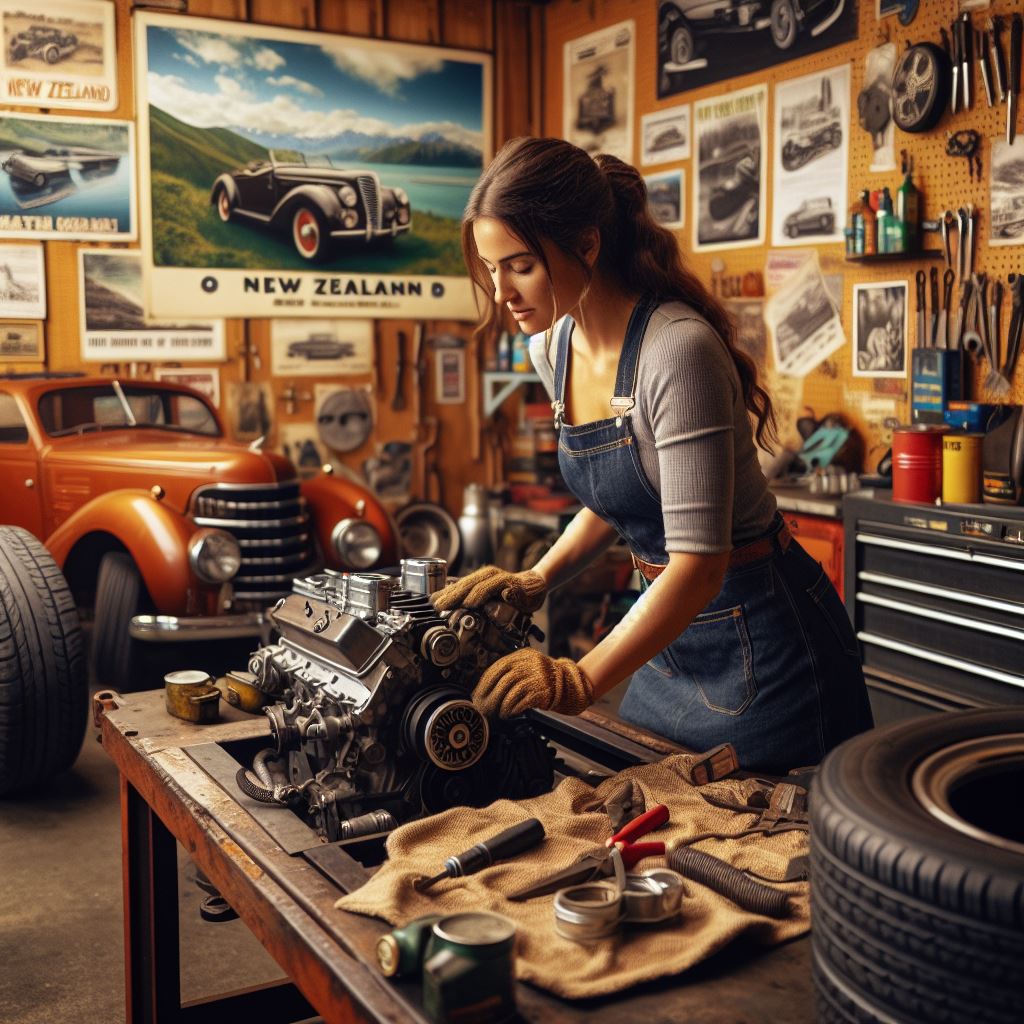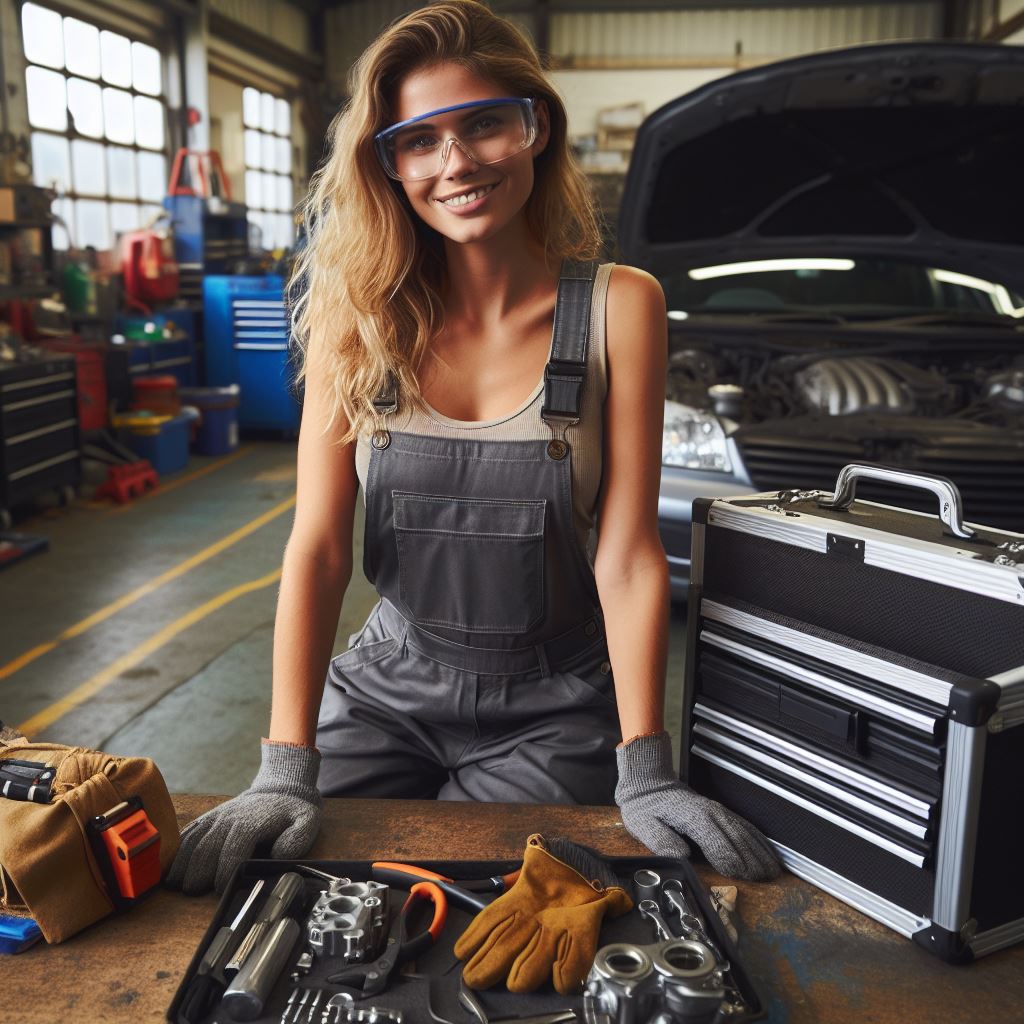Introduction
In recent years, there has been a significant rise in the number of women pursuing careers in mechanics in New Zealand.
This trend is reflective of the changing dynamics in the field, as women break traditional gender stereotypes and enter into what was once considered a male-dominated industry.
The increase in female mechanics can be attributed to various factors.
Firstly, there has been a conscious effort to encourage gender diversity in the automotive sector, with initiatives aimed at attracting more women to pursue careers in mechanics.
This has resulted in an influx of female students studying automotive engineering and related courses.
Moreover, societal attitudes towards female mechanics are evolving, and there is a growing acceptance of women in this traditionally male-dominated field.
Women have shown exceptional skills and determination in the industry, challenging the notion that mechanics is only suitable for men.
The rise of women in mechanics can also be attributed to the demand for skilled professionals in the automotive industry.
As cars become more complex and reliant on advanced technology, there is a need for a diverse workforce that can bring different perspectives and skills to the table.
In review, the trend of women in mechanics in NZ is gaining momentum.
More women are pursuing careers in this field, breaking barriers and contributing to the growth and success of the automotive industry.
With increased support and opportunities, the future looks promising for women in the mechanics profession.
Historical context of women in the mechanical industry
While women have made significant strides in various professions, the mechanical industry has remained largely resistant to change.
Gender biases and stereotypes have persisted, making it difficult for women to establish their presence in the field.
However, in recent years, there has been a noticeable shift in the perception of women in mechanics. Women are challenging traditional gender roles and proving their competence and abilities in this field.
The traditional gender roles in the mechanical industry
The traditional gender roles enforced in the mechanical industry have hindered women from pursuing careers in this field.
The perception that mechanical work requires physical strength has unfairly excluded women, despite their potential for success in this area.
These gender stereotypes and societal expectations have limited women’s opportunities in the mechanical industry.
Instead of being encouraged to pursue their interests and talents, they were redirected towards more traditional “feminine” careers.
Challenges faced by women entering the field historically
Women faced numerous challenges when attempting to enter the mechanical industry historically.
Resistance and discrimination were common, with recruiters often doubting their abilities and denying them employment opportunities.
Hostile work environments, characterized by harassment and lack of support, further discouraged women from pursuing careers in mechanics.
The underrepresentation of women in trade unions made it difficult to collectively address these challenges and fight for equal treatment.
Additionally, the limited access to education and training opportunities for women perpetuated the gender disparity in the mechanical industry.
Despite these barriers, women are now breaking through the glass ceiling in the mechanical industry.
The growing trend of women entering traditionally male-dominated trades is empowering and inspiring.
Organizations and initiatives have been established to support women in mechanics, providing mentorship, training, and advocacy.
These efforts are crucial in creating a more inclusive and diverse workforce in the mechanical industry.
It is through challenging gender norms and addressing historical biases that women are gaining recognition for their skills and contributions in the mechanical industry.
The tide is turning, and as more women enter and succeed in this field, the visibility of women in mechanics will continue to increase, promoting gender equality and fostering a culture of inclusivity and innovation.
With the determination and resilience of women in the mechanical industry, the historical context is being rewritten, making way for a more balanced and progressive future.
Current state of women in mechanics in NZ
Statistics and data on the number of women in the mechanical industry
- According to recent statistics, women make up only a small percentage of the mechanical industry in NZ.
- In 2020, women accounted for just 15% of the total workforce in the field of mechanics.
- This low representation of women in the industry can be attributed to various factors, including societal norms and stereotypes.
- The statistics also reveal a significant gender pay gap within the mechanical industry, with women earning less than their male counterparts.
- These numbers highlight the need for greater gender diversity and equality in the field of mechanics.
Increase in the number of women pursuing careers in mechanics
- Despite the challenges, there has been a noticeable increase in the number of women pursuing careers in mechanics.
- In recent years, there has been a growing awareness about the opportunities available in the mechanical industry for women.
- This shift in perception has encouraged more young women to consider a future in mechanics.
- Many vocational training institutions are also actively promoting and supporting women to enter the field of mechanics.
- The increase in the number of women in the industry is a positive sign of progress towards gender equality and diversity in NZ.
Women in different specialized areas within mechanics
- Women are no longer limited to traditional roles within the mechanical industry.
- There has been a significant increase in the number of women pursuing specialized areas within mechanics, such as automotive engineering and aircraft maintenance.
- This diversification of roles showcases the competence and skills of women in the field.
- Women mechanics have proven themselves in traditionally male-dominated areas and have gained recognition for their expertise.
- Their presence in such specialized areas is breaking down stereotypes and inspiring other women to follow suit.
In essence, although the current state of women in mechanics in NZ still shows a significant gender imbalance, there are positive signs of progress.
The increase in the number of women pursuing careers in mechanics and their presence in specialized areas is a testament to their competence and determination.
It is crucial to continue promoting gender diversity and equal opportunities within the mechanical industry to create a more inclusive and balanced workforce.
Factors contributing to the growing trend
Changes in society’s perception of gender roles
- Over the past few decades, there has been a significant shift in how society views gender roles.
- Traditional notions that certain careers are only suitable for men and others for women are being challenged.
- This change in perception has opened up opportunities for women to pursue careers in male-dominated fields.
- Women are now seen as equally capable as men in fields that were once considered exclusive to males.
Advocacy and support for women in traditionally male-dominated fields
- Various organizations and initiatives have been established to support and promote the inclusion of women in male-dominated fields.
- These advocacy groups work to eliminate barriers that women face when entering into these industries.
- They provide mentorship programs, networking opportunities, and resources to help women succeed in these fields.
- The support and encouragement from these organizations have empowered many women to pursue careers in traditionally male-dominated fields.
Promotion of STEM education among girls in NZ
- STEM (Science, Technology, Engineering, and Mathematics) education is crucial in preparing individuals for careers in mechanics.
- In recent years, there has been a focused effort to encourage girls in New Zealand to pursue STEM education.
- Schools and organizations have implemented programs that aim to engage girls in STEM-related subjects from an early age.
- By promoting STEM education among girls, more women are being exposed to the mechanics industry and are encouraged to pursue it as a career.
- These initiatives include hands-on activities, mentorship programs, and highlighting successful women who have excelled in STEM fields.
- The promotion of STEM education is gradually closing the gender gap in industries like mechanics.
- As more girls become interested in STEM, the number of women entering the mechanics profession continues to increase.
In fact, several factors have contributed to the growing trend of women in mechanics in New Zealand.
Changes in society’s perception of gender roles, advocacy and support for women in male-dominated fields, and the promotion of STEM education among girls have played significant roles in this shift.
These factors have not only opened up career opportunities for women but also challenged traditional gender norms.
As a result, more women are pursuing careers in mechanics, contributing to a more diverse and inclusive workforce in the industry.
Read: Carpentry 101: A Guide for Kiwi Beginners

Success stories of women in the mechanical industry
Profile successful women mechanics in NZ
- Emma Thompson – Started as an apprentice, now owns her own auto repair shop.
- Sarah Jackson – Overcame stereotypes to become a renowned diesel engine specialist.
- Rachel Chen – Pioneered the development of electric vehicles with her innovative engineering skills.
- Jessica Walker – Worked her way up to become the head mechanic at a leading automotive company.
Achievements and contributions to the field
- Emma Thompson’s success story shows that women can excel in traditionally male-dominated industries.
- Sarah Jackson’s expertise in diesel engines has revolutionized the way they are maintained and repaired.
- Rachel Chen’s groundbreaking work in electric vehicles has contributed to reducing carbon emissions.
- Jessica Walker’s leadership as a head mechanic has inspired many women to pursue careers in the mechanical industry.
Emma Thompson
Emma Thompson, a successful woman mechanic in New Zealand, has defied all odds to make a name for herself in the auto repair industry.
Starting as an apprentice, she gained hands-on experience and knowledge that led her to open her own auto repair shop.
With her exceptional skills and commitment, Emma has earned a reputation for providing top-notch service to her customers.
Sarah Jackson
Sarah Jackson is another remarkable woman who has made significant contributions to the mechanical industry in New Zealand.
Despite facing gender stereotypes, she persevered and became an expert in diesel engines.
Her expertise and innovation in maintaining and repairing diesel engines have not only made her a respected professional but have also helped improve the performance and efficiency of diesel-powered vehicles.
Rachel Chen
Rachel Chen is a pioneer in the development of electric vehicles in New Zealand.
Her engineering skills and dedication to environmental sustainability led her to create innovative solutions for electric vehicle technology.
Rachel’s work has contributed to the reduction of carbon emissions and paved the way for a greener future in the automotive industry.
Personalized Career Consulting
Unlock your potential with expert career advice tailored to your goals. Get personalized guidance and actionable steps toward your dream career in New Zealand.
Get StartedJessica Walker
Jessica Walker’s journey in the mechanical industry is an inspiring one.
Starting as a mechanic, she showed exemplary skills and dedication, eventually rising to become the head mechanic at a leading automotive company.
Jessica’s leadership and expertise have not only propelled her career but have also inspired numerous women to pursue their passion for mechanics.
These success stories showcase the achievements and contributions of women in the mechanical industry in New Zealand.
Through hard work, determination, and expertise, these women have broken barriers and paved the way for a more inclusive and diverse workforce.
Their stories serve as a motivation for aspiring female mechanics to pursue their dreams and make their mark in a field traditionally dominated by men.
In summary, the success of women in the mechanical industry in New Zealand is a growing trend that cannot be ignored.
Emma Thompson, Sarah Jackson, Rachel Chen, and Jessica Walker are remarkable examples of how women are excelling in this field.
Their achievements and contributions not only benefit the industry but also inspire countless others to pursue their passions and challenge gender stereotypes.
With more opportunities and support, women in mechanics will continue to thrive and contribute to the growth and innovation of the industry.
Read: Top Carpentry Courses in New Zealand
Challenges faced by women in the mechanical industry
The persistent gender bias and stereotypes
- Women in the mechanical industry often face entrenched gender bias and stereotypes.
- These biases perpetuate the notion that mechanical work is a male-dominated profession.
- It is crucial to challenge and debunk these stereotypes to promote diversity and inclusivity.
- Encouraging more women to pursue mechanical careers can help break down these barriers.
- Education and awareness programs can play a vital role in promoting gender equality in the industry.
- By highlighting successful women in the mechanical field, we can demonstrate that gender is irrelevant to skill and competence.
- It is essential to create an environment that recognizes and values the contributions of women.
- Employers should provide equal opportunities for women and advocate against discriminatory practices.
The need for equal opportunities and workplace support
- Achieving gender equality in the mechanical industry requires equal opportunities for both men and women.
- Women should have access to training, apprenticeships, and career advancement opportunities.
- Employers should actively promote and support women in achieving leadership positions within their organizations.
- Addressing the wage gap is crucial in ensuring fair treatment and equal financial compensation for women.
- Workplace policies should be gender-neutral and provide support for work-life balance.
- Employers should establish mentorship programs where experienced women can guide and support younger female mechanics.
- Promote an inclusive workplace culture that celebrates diversity and respects everyone’s contributions.
- It is important to recognize the specific challenges women face in the mechanical industry and provide tailored solutions.
- Collaboration between industry leaders, government agencies, and educational institutions is key to driving change.
- By working together, we can create a more inclusive and supportive environment for women in the mechanical industry.
In general, women in the mechanical industry face challenges such as persistent gender bias and stereotypes.
To overcome these challenges, it is crucial to address and debunk these biases.
Additionally, providing equal opportunities and workplace support is essential to achieving gender equality.
By creating an inclusive environment, promoting diversity, and recognizing the contributions of women, we can foster positive change in the mechanical industry and encourage more women to pursue careers in this field.
Read: NZ Carpentry: Skills and Tools Needed
Strategies for promoting diversity in mechanics
Encourage more young girls to pursue mechanical careers
One way to promote diversity in mechanics is by inspiring and motivating young girls to consider mechanical careers.
By challenging gender stereotypes and showcasing successful women in the field, we can create a supportive environment that encourages girls to pursue their passions.
Mentorship programs for aspiring women mechanics
Creating mentorship programs specifically tailored for aspiring women mechanics is crucial.
Pairing them with experienced women in the industry can provide guidance, support, and valuable insights to navigate the challenges they might face.
Foster an inclusive and supportive work environment
Building an inclusive and supportive work environment is essential for attracting and retaining women in mechanics.
This can be achieved by implementing inclusive policies, providing training on gender biases, fostering open communication, and addressing gender-related issues promptly and effectively.
Read: Carpenter Apprenticeships in NZ Explained
Conclusion
The trend of women entering the field of mechanics in New Zealand has been steadily growing over the past decade.
From apprenticeships to established professionals, more women are breaking into what was once considered a male-dominated industry.
This surge in diversity brings with it a multitude of potential impacts.
Firstly, it fosters a more inclusive work environment, where different perspectives and experiences can contribute to innovation and problem-solving.
Additionally, it helps dismantle stereotypes and biases surrounding gender roles in technical fields, paving the way for future generations of women to pursue careers in mechanics without hesitation.
As we look to the future, the prospects for women in mechanics appear promising.
Female mechanics in New Zealand will thrive due to efforts promoting diversity, recognizing women’s valuable contributions.
However, it’s essential to remain vigilant in addressing any remaining barriers or challenges that may hinder progress, ensuring equal opportunities for all individuals passionate about pursuing a career in mechanics.




